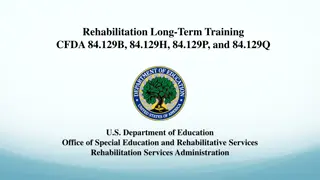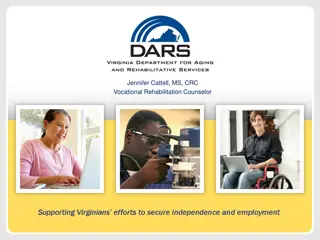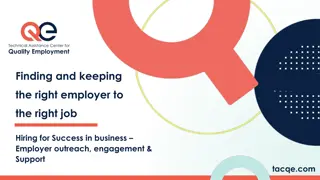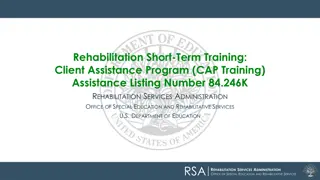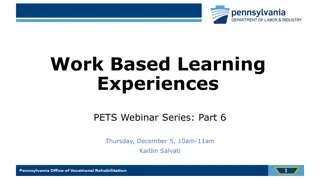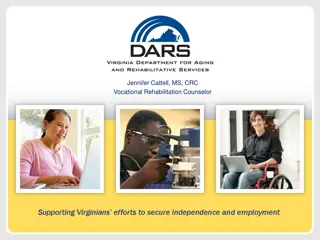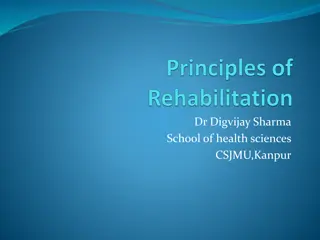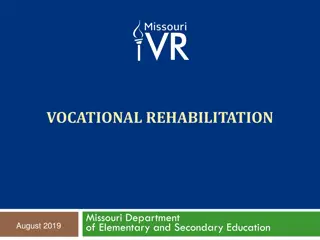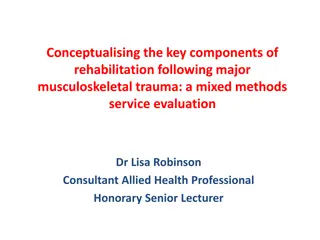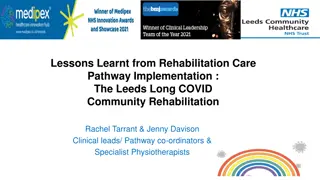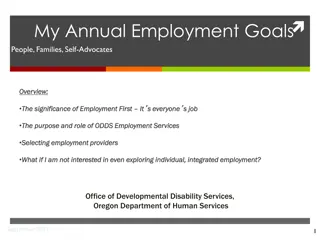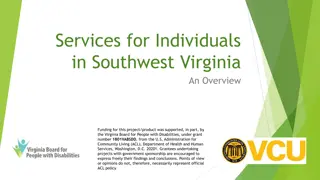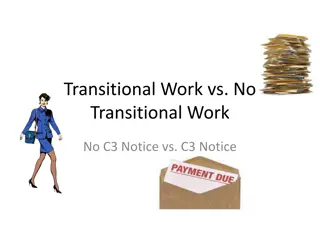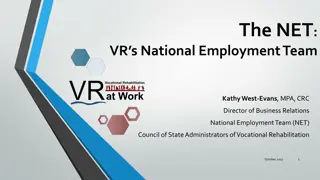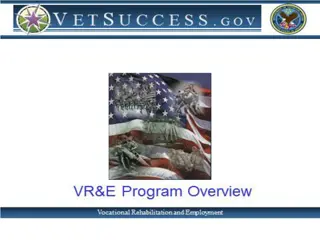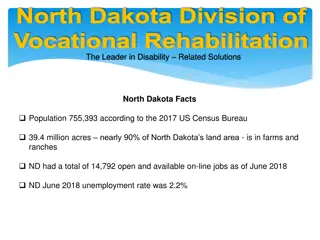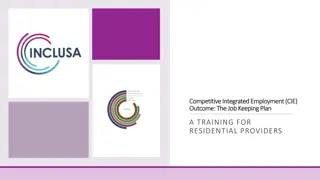Exploring Long-Term Employment Outcomes of Vocational Rehabilitation Applicants
This study utilized linked administrative data to examine the outcomes of Vocational Rehabilitation (VR) applicants up to 7 years after program exit. Findings showed varied outcomes based on employment status at closure, with better results for those who closed with employment. The research linked RSA data to SSA data to analyze earnings, benefit suspension/termination, and new benefit receipt. The study highlighted the importance of evaluating longer-term outcomes for individuals with disabilities participating in vocational rehabilitation programs.
- Vocational Rehabilitation
- Administrative Data Analysis
- Long-Term Employment Outcomes
- Disability Services
- Linked Data Analysis
Download Presentation

Please find below an Image/Link to download the presentation.
The content on the website is provided AS IS for your information and personal use only. It may not be sold, licensed, or shared on other websites without obtaining consent from the author. Download presentation by click this link. If you encounter any issues during the download, it is possible that the publisher has removed the file from their server.
E N D
Presentation Transcript
Using Administrative Data to Explore the Employment and Benefit Receipt Outcomes of Vocational Rehabilitation Applicants Years after Program Exit David R. Mann, Todd Honeycutt, Michelle Stegman Bailey, and John O Neill Presented at the State of the Science Conference Washington, DC February 13, 2017
Vocational Rehabilitation (VR) program overview VR supports people with disabilities who want to work Application is voluntary SSI and SSDI beneficiaries can apply Administered at state level 2
The RSA data are a great source of information on VR applicants Rehabilitation Services Administration (RSA) collects VR administrative data The RSA-911 files contain case report data on all closed VR cases The files contain information on Applicant characteristics VR services received Status at closure Some key limitations Data collection currently ends at program exit Limited information for those who didn t receive services 3
VR data do not provide information on outcomes after program exit 4
Linked administrative data enable us to look at longer-term outcomes! 5
Study overview Used linked data to examine applicant outcomes up to 7 years after program exit Earnings SSI and SSDI benefit suspension/termination New SSI and SSDI benefit receipt Estimated regression-adjusted models Outcomes varied by status at closure (relative to those not receiving services) Poorer for those who closed without employment Better for those who closed with employment 6
We linked RSA data to SSA data Data sources RSA-911 files SSA data files Disability Analysis File Master Earnings File All records closed in 2004-2006 1,779,204 records Age restrictions for SSA outcome analyses Records linked by Social Security number SSA collaborator accessed the data 7
Select descriptive statistics Sample characteristics by SSI and SSDI benefit status at VR program exit No SSI or SSDI Both SSI and SSDI Total SSI only SSDI only 1,779,204 1,153,252 206,108 299,581 120,263 N Received VR services 58.2% 58.5% 55.2% 60.8% 54.4% Employed at application 19.2% 24.2% 6.6% 12.9% 9.3% Employed at closure 33.5% 38.8% 19.9% 29.1% 17.3% 8
Key earnings and benefit receipt outcomes up to 7 years after closure Earnings Employment: earned a quarter of coverage SGA employment: earned annualized SGA amount SSI and SSDI benefit suspension/termination Sample: beneficiaries at closure Variables in SSA data New SSI and SSDI benefit receipt Sample: non-beneficiaries at closure 9
Estimated regression-adjusted models Basic descriptive statistics Estimated two types of models Logistic regression Negative binomial regression Present odds ratios and incidence rate ratios Estimated correlations, not causal effects 10
Earnings outcomes varied greatly by employment status at program exit Incidence rate ratio for an additional year of employment (during the first six full calendar years after closure) 1.60 1.48 1.40 1.34 1.20 Incidence rate ratio 1.00 0.80 0.75 0.60 0.67 0.40 0.20 0.00 Employment SGA Employment Closed with Employment Closed without Employment 11
Being employed at program exit was a strong indicator of future benefit suspension Incidence rate ratio for an additional month of benefit suspension/termination (during the first seven calendar years after closure) 4.00 3.50 3.41 Incidence rate ratio 3.00 3.18 2.50 2.00 1.50 1.00 1.00 0.50 0.75 0.00 SSDI SSI Closed with Employment Closed without Employment 12
Those who exit VR with employment were more likely to become SSDI beneficiaries Odds ratio for new benefit receipt (within seven calendar years after closure) 1.60 1.40 1.37 1.20 1.19 1.00 1.07 Odds ratio 0.80 0.87 0.60 0.40 0.20 0.00 SSDI SSI Closed with Employment Closed without Employment 13
Some general takeaway findings Applicants who did not receive services are a relatively heterogeneous group Case closure status acts as a sorting mechanism New benefit receipt varies by program Differences in program rules Difference in beneficiary populations Other factors 14
Additional earnings findings for those who received services Women less likely than men to earn above the SGA amount for an additional year Additional employment most likely among those ages 19 to 24 (and declines with age) Those with substance abuse impairment least likely to obtain additional employment SSI and SSDI benefit receipt highly correlated with low earnings 15
Additional new benefit receipt findings among recipients of services Women more likely than men to be SSI recipients The converse true for SSDI benefits SSI and SSDI benefit receipt increases with age Higher educational attainment negatively correlated with benefit receipt Those with developmental disabilities most likely eventual SSI and SSDI beneficiaries 16
Implications for policy and practice Opportunity to target further assistance to VR clients approaching program exit Those struggling to find employment may be candidates for other services and supports for people who are not economically independent Those exiting with employment may benefit from additional employment services and supports to sustain employment Findings suggest a possible benefit of VR service receipt via increased resources or in response to poor economic environments 17
Citation Mann, David R., Todd Honeycutt, Michelle Stegman Bailey, and John O Neill. Using Administrative Data to Explore the Employment and Benefit Receipt Outcomes of Vocational Rehabilitation Applicants Years after Program Exit. Journal of Vocational Rehabilitation, forthcoming. 18
Contact information David R. Mann, Ph.D. Senior Researcher Mathematica Policy Research dmann@mathematica-mpr.com @DavidRMann
Acknowledgments Funding for this study was provided by the Research and Training Center on Disability Statistics and Demographics at the University of New Hampshire, which is funded by the National Institute for Disability, Independent Living, and Rehabilitation Research (NIDILRR), in the Administration for Community Living (ACL), at the U.S. Department of Health and Human Services (DHHS) (Grant No: 90RT5022-02-00) The contents of this presentation do not necessarily represent the policies of DHHS or of any other federal agency (EDGAR, 75.620 [b]) 20



